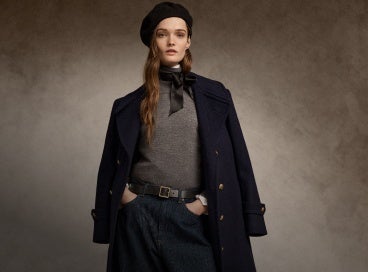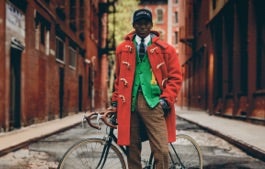
THE RL Q+A: The Voices of Morehouse and Spelman
Four professors and alumni on the history, legacy, and style of the iconic collegesDr. Karcheik Sims-Alvarado
Assistant Professor of Africana Studies, Morehouse College
Clark Atlanta University Alumni, Class of 1996
On the power of dressing and identity…

“Clothing says so much about who we are. Anyone who’s attended an HBCU on a beautiful day will see students walking the promenade, looking as if it’s coronation every day. People are constantly communicating a message with their bodies and with their clothing about how they want to project themselves to the world. It was really moving for me watching the men being staged for a set on Spelman’s campus. I remember thinking to myself, ‘I’ve seen this image before in the photographs of Thomas E. Askew,’ who photographed students for a number of years throughout the Atlanta University Center. There was so much care that Askew put into staging individuals, even in small things like rolling down the socks for athletes, positioning the bodies, having the subjects turn their heads in a certain direction, and bringing that whole image together to create a portrait for the world to see.
I came to fall in love with history through my love of photography, art, and fashion. One of the earliest Black images that you see of people of African descent in photography was of a Black man and a Black woman. They were being photographed by a zoologist at Harvard University. I remember seeing the images of the enslaved woman and man, who turned out to be a son and daughter—Delia and Renty Taylor. I want to say their names because I want to humanize them. In this image, they were being dehumanized.
The zoologist wanted to try to prove that the subjects were biologically different than whites and they were both undressed in the photograph. By taking away their clothing, it was as if their dignity or their humanity was being stripped from them. If you look closely at the photograph, you see both of the subjects crying. But then when you fast forward, and you look at Thomas E. Askew’s images, the way that he’s intentionally dressing and staging the subjects, the women and men who belong to HBCUs, he’s given them back their dignity because of the way that their bodies are being fashioned with clothing. So, clothing says so much. Photography says so much. When we look at Frederick Douglass, his wife actually made his clothes. His wife—his girlfriend at the time who became his wife—helped him to become free because she made him a sailor’s uniform. No one could tell that he was a slave because he wasn’t dressed like one. He was dressed like a sailor. He was dressed like a free man. And when we see him in subjects, we don’t see a slave. We see a man with dignity. Frederick Douglass always adorned his body beautifully with clothing made by his wife. I love the way he would stare into the camera with his salt-and-pepper hair parted to the side, the waves cascading to the back. He would look into the camera and he would tell you that he’s a man, and he’s not a slave.”
Dr. David Wall Rice
Professor of Psychology at Morehouse College
Morehouse College Alumni, Class of 1995
On collaborating with Polo Ralph Lauren…
“For me, the significance of this collection is layered. As a professor, I get excited about the idea of my students seeing themselves represented so elegantly and appropriately. As a father of two boys, to be able to go to a high-end store and point out apparel that has Morehouse College on it is significant. I don’t want to say that it validates, because we are already validated. We understand that Black genius and Black brilliance has been around since Black folk. But to have that cosign, to have that visibility within a very American popular space is something that I take great pride in being able to share with my boys. And then as a graduate of the college, there’s that part of me, so being able to hang my hat on the fact that this is a quality product and that there was such a significant investment in the lived experience of Black folk at college, it means something.
To be able to look at a company that has made a variety of looks, a variety of expressions of identity, across formalwear, across casualwear, across sportswear is special because it gives you a full scope and a full arc of how it is that people live. To have a single article of clothing is one thing. But to have a line that has a variety of articles of clothing by which to express yourself, it says something about how it is that your lived experience and the expression of who you are is important, not only to you but to be celebrated and expressed by others as well. So, when we’re looking at this line that is highlighting and underscoring the significance of learning spaces that are Spelman College and Morehouse College, what it says is that you too are called to examine the significance of the education that takes place in these spaces.

I felt great to be a part of this legacy as a graduate of Morehouse College. I’m a part of its future because I teach students from Morehouse, Spelman, and Clark Atlanta University. I teach students from Howard University. These institutions are a flagship for what it is that historically Black colleges and universities have done for America writ large since their founding.”
Henry M. Goodgame Jr.
Vice President for External Relations and Alumni Engagement at Morehouse College
Morehouse College Alumni, Class of 1984
On becoming a Morehouse man…
“Growing into manhood at Morehouse was key for me. Although my mother and father continued to stay friends throughout my entire time, they divorced when I was 10. But everybody around me in my community and my home church and my environment, including my father, my great-grandfather, they had gone to Morehouse. And there were elements of Morehouse that said that there were things that I should get from Morehouse that would help refine me into a better man.
I took those same attributes and began to do what I could for young men that I met while here. The good thing about Morehouse is that we meet young men where they are. We meet them with their talents. We meet them with their struggles. We meet them with their triumphs, and we try to make them identify a way for us to mold the leader that’s inside them into what they think they should become. The beauty of Morehouse is actually trying to pull that which is confined inside them, whether it’s to be a leader, or a professor, or the consummate professional in whatever job they want to do. To try to help them find that light—the light is inside each one and our quest and our job is to help them find that light.

It’s a pleasure to talk about how iconic Morehouse was, even for a 17-year-old coming from Birmingham where the struggles of Birmingham were what the world knows that they were. The beauty of Birmingham, and the community that launched me to Morehouse, was that it always knew that I was destined to do something bigger and greater than what others could limit me to.
There was a book once I got from Sidney Poitier that he had written and I read. In it, there is a point that said, ‘Never let anybody define the value of your worth.’ And I learned that before I even knew the lesson. That I was coming to a place where I could, as the marketing material said when I was an incoming freshman, be somebody. Be a Morehouse man. That spoke volumes to me. Because I was destined to be somebody. You can become somebody anywhere, but can you become somebody with purpose? That’s what I found at Morehouse.”
Kelli Daniels
Spelman College Alumni, Class of 2015
On sisterhood at Spelman…
“My grandmother’s second cousin was the first person in our family who attended Spelman. And her sister attended, as well as her niece. My mother graduated from Spelman. She paved the way for my sister and myself, as well as my younger cousin, her sister, and our cousins moving up that are still in high school. To be a part of a heritage of Spelman women, a part of such a strong, rich sisterhood—it’s a gift. When my uncle and my aunt had their first daughter, my sister and I took her to Spelman so that she could step on the grounds and understand how wonderful that experience is, even as a little girl.
During my senior year, we were getting excited for our spring semester to celebrate Founders Day and Class Day. But my father actually passed away my last week at Spelman College. We had to hold his funeral on Class Day. At Spelman, sisterhood is like no other. I found my best friends there. My cousin was able to attend with me. We did everything together, and on Class Day, instead of them enjoying the moment we’ve been waiting for all four years, all of my best friends, a couple of my Spelman sisters, my cheer coach (because I cheered for Morehouse), and my cheer sisters decided to come down to Griffin, Georgia, in their all-white outfits ready for Class Day. As I walked through the door ready to send my father his special blessings, I saw my Spelman sisters and my Morehouse brothers sitting right there to support me. On a very special day for all of us, they were willing to come down to Griffin to support me. So, sisterhood is everything, but Spelman sisterhood is like no other.”

- Images Courtesy of Nadine Ijewere







